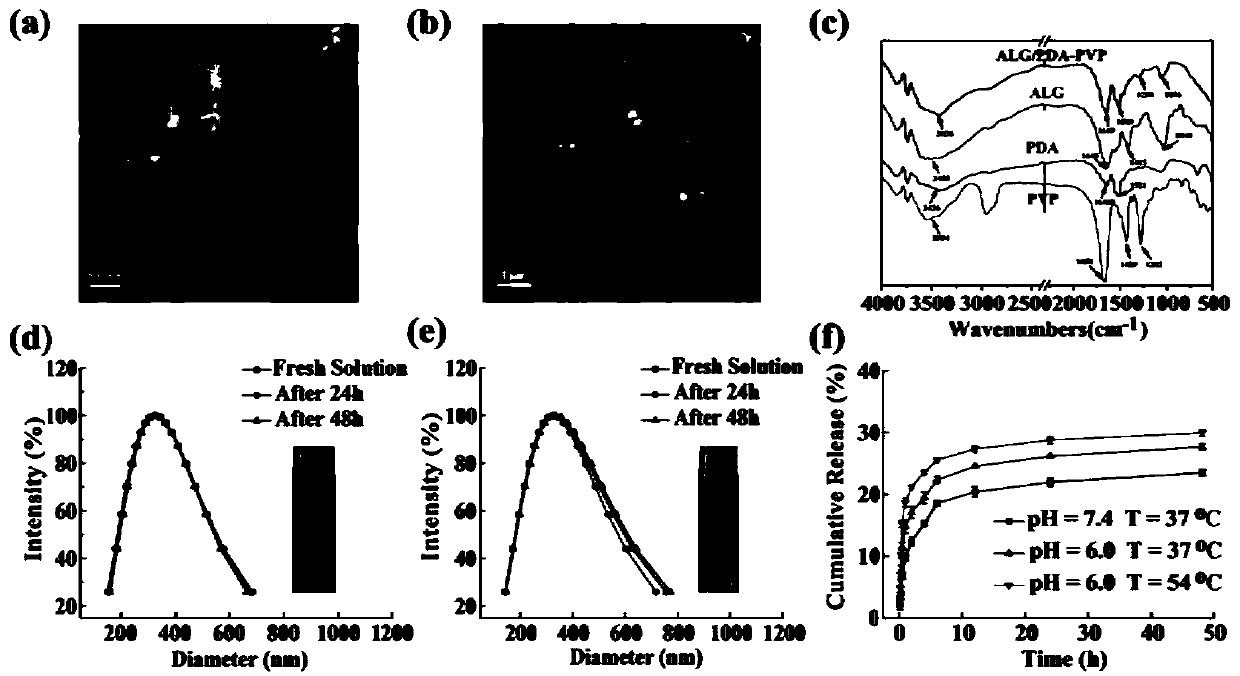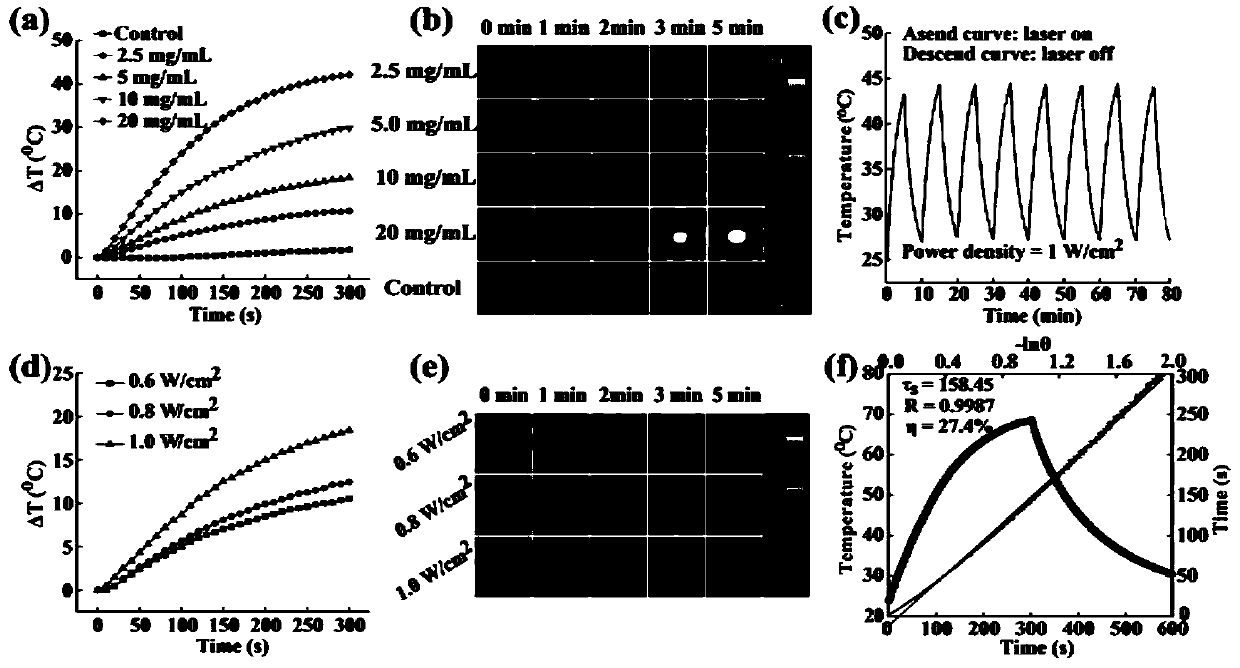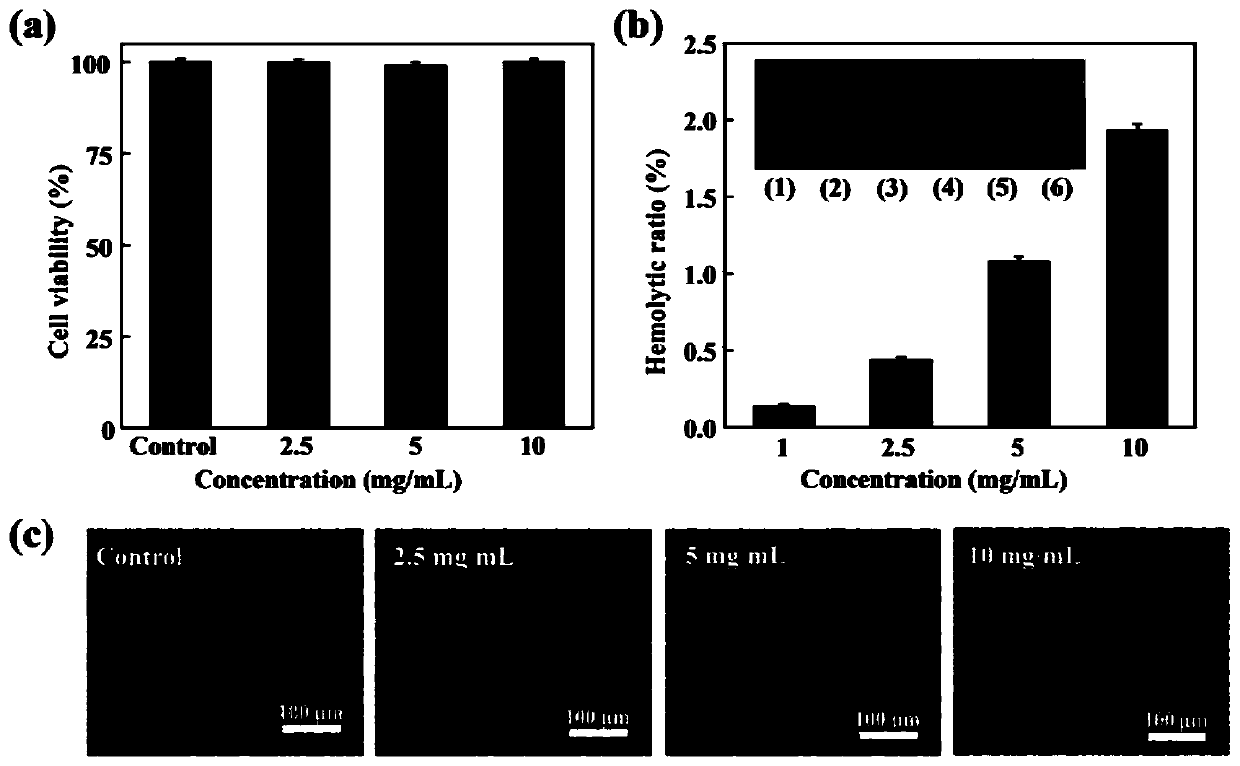PVP-modified sodium alginate/polydopamine composite nano-material and preparation and application thereof
A technology of composite nanomaterials and sodium alginate, which is applied in the direction of medical preparations with non-active ingredients, wave energy or particle radiation treatment materials, medical preparations containing active ingredients, etc., can solve complex synthesis processes, low photothermal efficiency, Limiting the application of tumor therapy and other issues, to achieve the effects of broad application prospects, excellent photothermal transfer efficiency, controlled drug release ability, and excellent in vivo/in vitro biocompatibility
- Summary
- Abstract
- Description
- Claims
- Application Information
AI Technical Summary
Problems solved by technology
Method used
Image
Examples
Embodiment 1
[0032] A preparation method of sodium alginate / polydopamine composite nanomaterial modified by PVP, the specific steps are:
[0033] Step 1: 0.2g sodium alginate is dissolved in distilled water (10mL), prepares 2% sodium alginate solution, then, dopamine hydrochloride is dissolved in the above-mentioned solution, stir constantly, obtain the aqueous solution containing sodium alginate and dopamine ( Weight ratio ALG:DA=1:1).
[0034] Step 2: In CaCl 2 2H 2 Tris (Tris) was added to the aqueous solution of O and PVP to adjust the pH=10 to obtain a coagulation bath, wherein, Ca 2+ The ion concentration was 2%, the PVP concentration was 1%, and the Tris concentration was 0.5%.
[0035] Step 3: Using the electrostatic spraying method, spray the aqueous solution containing sodium alginate and dopamine into the coagulation bath at a constant speed using a push injection device, and form a jet under the action of electrostatic force and surface tension. The entire electrostatic sprayi...
Embodiment 2
[0037] The morphology and size of the ALG / PDA-PVP nanogel obtained in Example 1 were observed and measured by a scanning electron microscope. The hydrodynamic size of the particles and their stability are measured by dynamic light scattering. Using FTIR to analyze and measure the structure of ALG / PDA-PVP nanogel, through 4000~400cm -1 The transmission mode, collects data at a speed of 32 scans / min. Depend on figure 1 (a, b) It can be seen that the material synthesized in Example 1 has a spherical particle structure.
[0038] analyze figure 1 (c) It can be seen that the infrared spectrum of the ALG / PDA-PVP composite nanomaterial shows that the material is at 3438cm -1 , 1649cm -1 , 1519cm -1 , 1290cm -1 and 1056cm -1 There is an absorption peak. Of which 3500cm -1 The left and right are O-H or N-H stretching vibrations shared by ALG, PDA and PVP. 1650cm -1 The left and right are the C=O stretching vibrations on both ALG and PVP, and the 1520cm -1 The left and right...
Embodiment 3
[0040] Using a preparation method similar to that in Example 1, the difference is that step 1 also includes: dissolving DOX in an aqueous solution containing sodium alginate and dopamine (the final concentration of DOX is 1 mg / mL); the seaweed modified by PVP is obtained in step 3 After sodium alginate / polydopamine (ALG / PDA) composite nanogel, 2 mL of the prepared sample was centrifuged (10,000 rpm, 10 min), the gel was collected and washed three times with distilled water, and the resulting PVP-modified sodium alginate / polydopamine was collected. (ALG / PDA) composite nanogel and supernatant, and refrigerate the gel and supernatant for later use.
[0041] First use the ultraviolet-visible spectrophotometer to measure and draw the standard curve of DOX, and then measure the absorbance of the supernatant at a wavelength of 480nm. According to Lambert-Beer’s law, the concentration of DOX in the supernatant can be determined, thereby calculating the load efficiency. The steps of d...
PUM
| Property | Measurement | Unit |
|---|---|---|
| Concentration | aaaaa | aaaaa |
Abstract
Description
Claims
Application Information
 Login to View More
Login to View More - R&D
- Intellectual Property
- Life Sciences
- Materials
- Tech Scout
- Unparalleled Data Quality
- Higher Quality Content
- 60% Fewer Hallucinations
Browse by: Latest US Patents, China's latest patents, Technical Efficacy Thesaurus, Application Domain, Technology Topic, Popular Technical Reports.
© 2025 PatSnap. All rights reserved.Legal|Privacy policy|Modern Slavery Act Transparency Statement|Sitemap|About US| Contact US: help@patsnap.com



